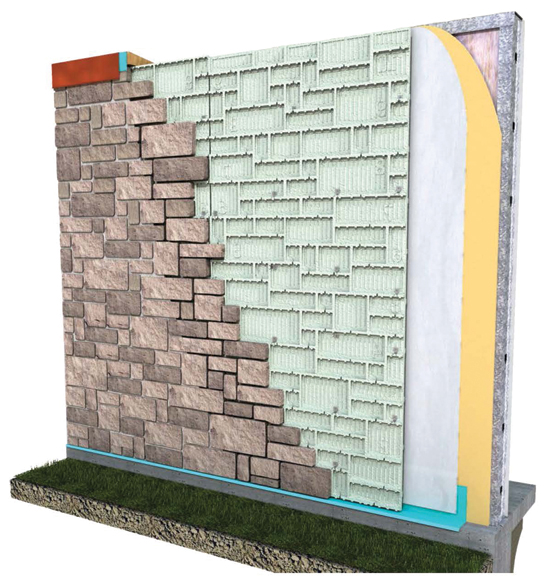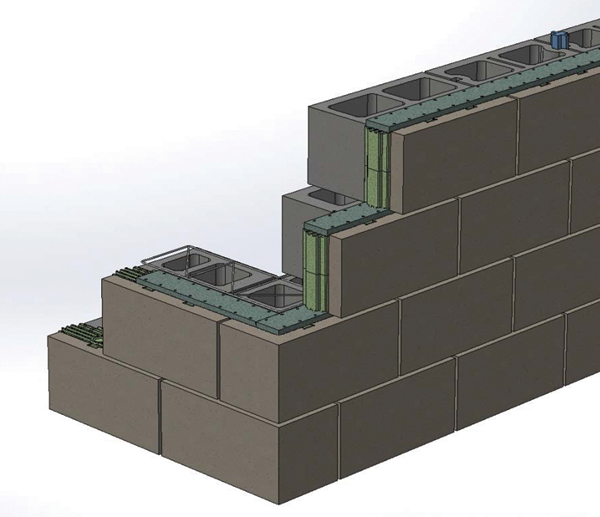Insulation Gets More Effective
Foam Panel Systems
Far preferable in a number of respects are foam panel wall systems. Rigid foam has been a key driver of energy-efficient construction over the last few decades as it gives a significant boost to R-values of walls and roofs with minimal increases in thickness. Further, it covers the framing elements, decreasing and sometimes eliminating the thermal bridging that is characteristic of cavity insulation. Rigid foam insulation can be airtight if properly sealed and taped at seams; air can go around but not through this insulation.
Types of Foam
Code- and ASTM-compliant foam plastic CI sheathing materials are available with various characteristics and profiles, to meet specific project requirements, the main types being expanded polystyrene (EPS), extruded polystyrene (XPS), and polyisocyanurate (polyiso) foam, all produced under various trade names. Each type of product has different thermal properties and associated influence on required thickness and costs.
Expanded polystyrene (EPS) ASTM C578 is the most economical type of rigid foam and has an R-value of about R-4.0 per inch. Similar to the foam used for impact protective packaging, soil subgrade load-bearing blocks, and floation augmentation for boating and floating, EPS is one of the most widely used types of rigid foam. In successful use for many years in areas where moisture is a concern, EPS “breathes” so that moisture is diffused. It has been found to resist the growth of fungi and bacteria, and to maintain performance properties when exposed to moisture and/or water. EPS insulation is available in a variety of densities to suit project needs, and is frequently used in commercial buildings for roof and wall panel insulation. ASTM C578 provides performance properties on this type of foam insulation.
Extruded polystyrene (XPS) rigid foam is usually blue or pink in color, with a smooth plastic surface, and available in a wide range of thicknesses and edge profiles. The R-value is about 5 per inch. Used widely in residential construction, this type of rigid foam will not absorb water like polyiso and is stronger and more durable than expanded polystyrene, making it a versatile type of rigid foam. XPS falls between polyiso and expanded polystyrene in price.
Polyisocyanurate, or polyiso, foam has the highest R-value per inch (R-6.5 to R-6.8) of any rigid insulation, and is the most expensive. This type of rigid foam usually comes with a reflective foil facing on both sides, so it can also serve as a radiant barrier in some applications. It is used widely in commercial applications and increasingly in residential structures.
Foams themselves can be one of two types: open- or closed-cell. In general, the key difference between the two types is density, which has implications when used in insulation. As closed-cell foam is the denser of the two materials, it offers increased R-value per volume, increased resistance of water vapor transmission, and increased rigidity, providing superior structural integrity. A 1-inch layer of closed-cell foam provides roughly the equivalent insulation factor as a 2-inch layer of open-cell foam, making the former particularly advantageous in tight spaces as thinner layers of insulation can be used. Closed-cell foams are superior insulators: They are strong and act as structural reinforcement for the insulated surface whereas open-cell foams have little structural strength. Open-cell foams typically have R-values of 3 to 4 per inch vs. closed-cell foams' R-values of 5 to 8 per inch. Another key difference is porosity. Open-cell foam is porous, which means moisture, both water vapor and liquid water, can penetrate the insulation. Closed-cell foam, on the other hand, is non-porous, and thus not moisture-penetrable.
Foam Masonry Panel System
Relatively new to the market, the foam masonry panel systems provide CI; they consist of foam panels, stainless steel screws or anchors, masonry units, and mortar. Type S mortar can be used, which has the advantage of additives to achieve easier pumping, better bonding, flexibility, and dimensional stability. A variety of masonry units are available including durable stone, clay, and concrete brick with others under development. Masonry units are friction fit in the foam, with different types of units having different foam panels.

Image courtesy of Oldcastle® Architectural
In a foam panel system, foam is applied over sheathing, flashing, and one to two layers of a weather-resistant barrier. Foam panels offer the advantage of CI, water control, and multiple patterns of face material.
The foam is the key to the efficacy of the unit, adding good water management with drainage on both sides to take away any water that may infiltrate the wall and protect the structure from damage over its service life of high moisture exposure. R-values are high as well—9.1 Steady State and 13.6 including Thermal Mass. An STC of 51 and an NCMA TEK 13-1B sound transmission rating for concrete masonry walls means loud sounds are only faintly heard and occupants can enjoy their space in peace and quiet. Some foam systems have been proven to resist wind speeds of more than 110 mph according to ASTM E330 with no lasting deformation, which essentially eliminates the structural risk of damage experienced with lighter-weight veneers. Fire resistance criteria notably NFPA 285 and ASTM E119 assures that tested foam walls have successfully withstood one hour of exposure to temperatures of more than 1,700°F. Foam panel systems should meet the aforementioned criteria.
To install the panels, foam is applied over sheathing, flashing, and one to two layers of a weather-resistant barrier. Stainless steel anchors are used for wood, steel, or concrete structures. Screws are used for wood studs, self-tapping screws for metal studs, and tapcons for concrete or CMUs. Protrusions along the top of the panel help stones to fit snugly into the foam. Some patterns have 10 different stone types. Concrete brick generally comes in 4-inch by 5-inch lengths, with +/- 3.25 bricks per square foot. Some manufacturers enable installation via an easy “paint by numbers” template. Mortar is then applied via an injection gun. Architects should be aware that manufacturers are constantly coming out with new masonry units and improved features for the foam wall panels. New options include 40 percent larger stone units; stacked stone; thin brick applications in 4 x 8 x 16; larger units up to 12 by 24 inches; larger foam panels up to 4 by 4; and redesigned anchors.
Foam systems have achieved energy efficient results. In Beaver Dam, Wisconsin, a foam system was used for an apartment complex rehabilitation that required both aesthetic improvements and enhanced energy efficiency. The level of energy efficiency achieved qualified the project for funding from the U.S. Housing and Urban Development (HUD) Green Retrofit Program. After installation, engineers working for Wisconsin's Focus on Energy program discovered that a 20 percent reduction in air infiltration had occurred compared to previous measurements. The foam panel system was also used in the ReVISION House Orlando 2011. Before renovations, the ReVISION House was a typical Florida concrete block-style home; while it had a durable wall system able to withstand termites and hurricanes, the structure lacked quality insulation. Prior to renovation, the R-2.5 walls were a major contributor to both heating and cooling loads. The “before” walls led to loads of 6.8 MBTU to heating and 14 MBTU to cooling on an annual basis. After renovating, annual loads dropped to 1.9 MBTUH for heating, and 2.5 MBTUH for cooling: a reduction of nearly 80 percent.
It should be noted, however, that these foam systems are not traditional masonry units. Rather, they are an insulated panel system that can be anchored to the exterior of different building sub-structures. The insulated panels have drainage planes built into both the front and rear as well as molded pockets or profiles that allow the veneer units to be held in place while the joints are mortared and struck and so is able to offer the aesthetics of traditional masonry.
Insulated Concrete Masonry Block Systems
Another, more recently developed option is the insulated concrete masonry block system (ICMS). Unlike the aforementioned options, the ICMS is a masonry system that consists of a pre-assembled structural masonry unit, molded EPS insulation insert and thin veneer face that is installed as a complete assembly. In other words the ICMS is the wall itself, and it is 100 percent thermally broken, providing true thermal protection, rather than that expressed by a nominal R-value. The units typically have a load-bearing capability of an 8-inch structural block. Blocks and thin veneer face units produced with keyway profiles add stability to the assembly.

Image courtesy of Oldcastle® Architectural
Insulated masonry block systems form the wall, and were specifically designed to be code compliant and energy efficient.
The all-in-one systems were designed specifically to be code compliant and, as such, reinforce the appeal of masonry on a number of levels. More advanced ICMS offer continuous insulation at R-15, thus meeting or exceeding 2012 IECC requirements for Climate Zones 1 through Zones 7, which covers the continental U.S. This level of code compliance is essentially achieved by the type of insulation that is incorporated into the system. Some ICMS utilize proprietary EPS foam insulation material that is made with high-purity graphite integrated into the polymer matrix—a formula that has shown superior insulation performance when compared to conventional EPS. In this mix, small black beads of EPS containing particles of graphite and a blowing agent, which makes it expandable. Because graphite reflects and absorbs radiant energy, the material's thermal conductivity is reduced and its R-value increased. This type of foam insulation has shown a long-term stable R-value ranging from 4.5 – 4.9 per inch at 75°F, depending on density.









